Business Environment Report: Business Environment Analysis and Primark
VerifiedAdded on 2020/02/12
|20
|6163
|197
Report
AI Summary
This report provides a comprehensive analysis of the business environment, using Primark as a case study. It begins by exploring different types of organizations and their purposes, specifically highlighting Primark as a public limited company and contrasting it with charity firms like NSPCC. The report then delves into stakeholder analysis, identifying key stakeholders such as shareholders, customers, employees, suppliers, and the government, and examining how Primark meets their objectives. It also discusses Primark's responsibilities, including stakeholder, legal, and ethical considerations, and the strategies employed to fulfill them. The report then moves on to economic systems, comparing planned, mixed, and transitional economies with examples from Cuba, the UK, and China, respectively. It further examines the impact of fiscal and monetary policies on businesses, specifically focusing on the housing and farming sectors in the UK. The report also evaluates the impact of competition policies and other regulatory mechanisms on organizations. Finally, the report considers market forces, pricing and output decisions in different market structures, and the influence of demand and supply, using examples to illustrate these concepts. The report concludes with a discussion on the significance of international trade, global factors, and the impact of EU policies on UK business organizations.
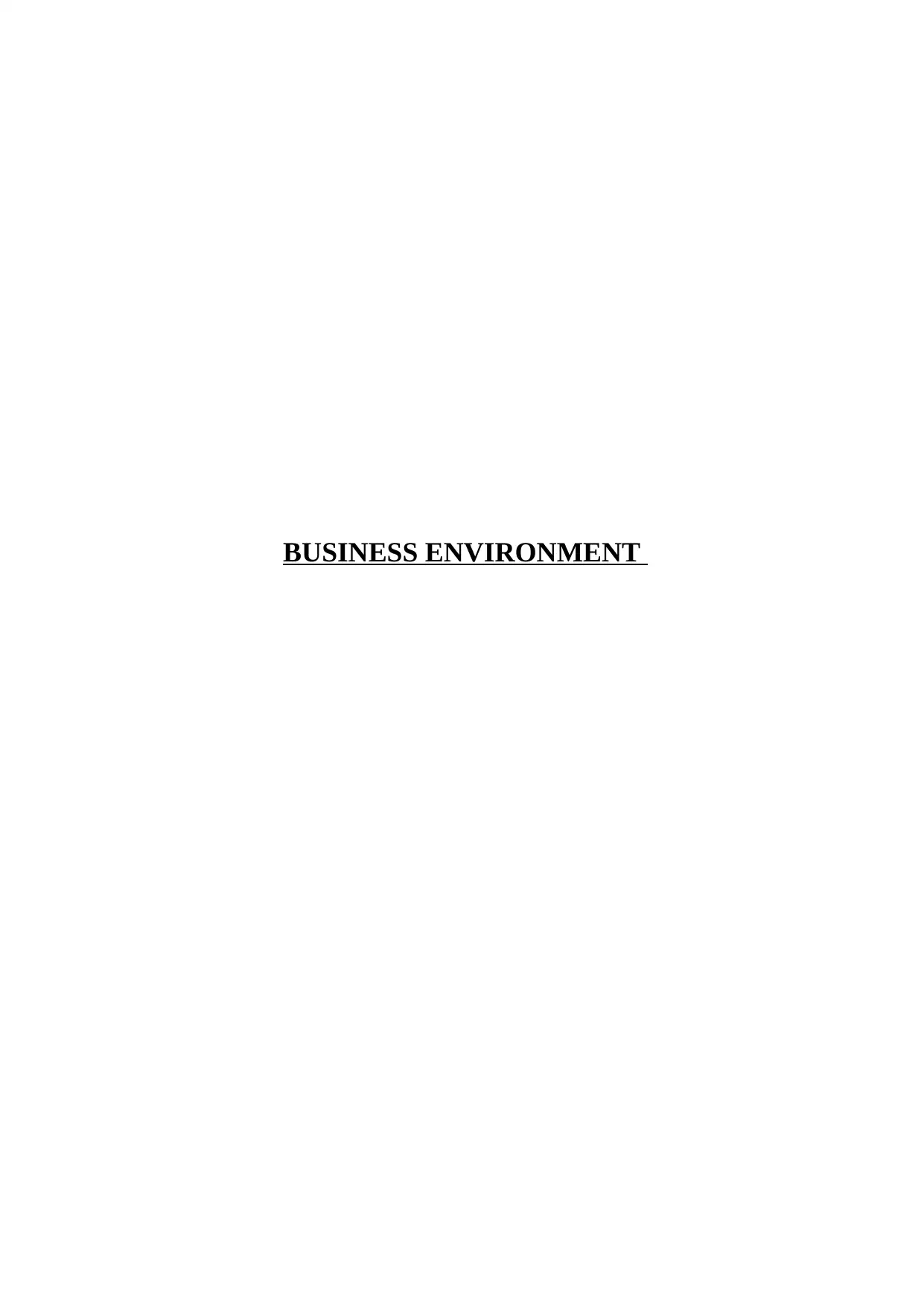
BUSINESS ENVIRONMENT
Paraphrase This Document
Need a fresh take? Get an instant paraphrase of this document with our AI Paraphraser
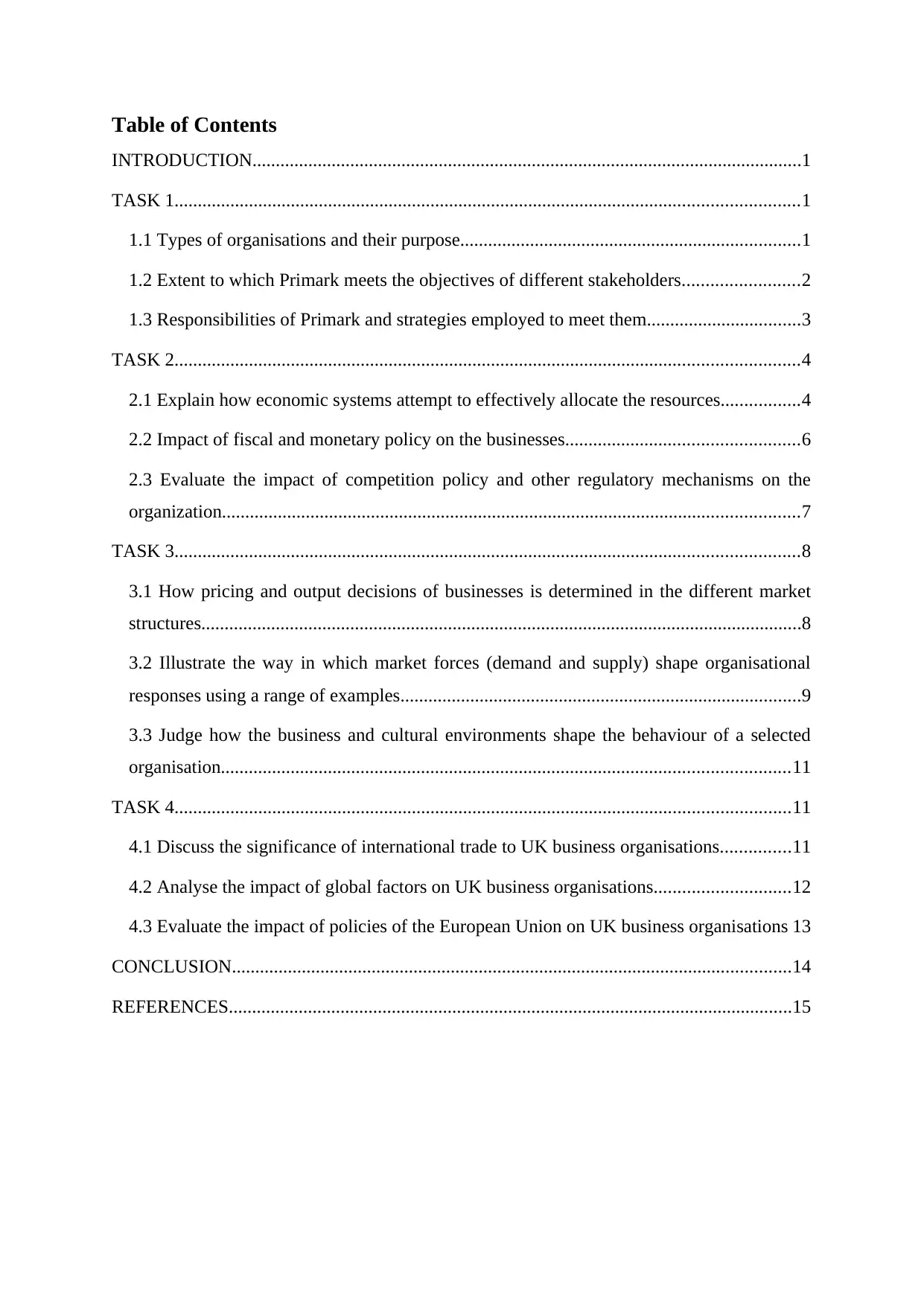
Table of Contents
INTRODUCTION......................................................................................................................1
TASK 1......................................................................................................................................1
1.1 Types of organisations and their purpose.........................................................................1
1.2 Extent to which Primark meets the objectives of different stakeholders.........................2
1.3 Responsibilities of Primark and strategies employed to meet them.................................3
TASK 2......................................................................................................................................4
2.1 Explain how economic systems attempt to effectively allocate the resources.................4
2.2 Impact of fiscal and monetary policy on the businesses..................................................6
2.3 Evaluate the impact of competition policy and other regulatory mechanisms on the
organization............................................................................................................................7
TASK 3......................................................................................................................................8
3.1 How pricing and output decisions of businesses is determined in the different market
structures.................................................................................................................................8
3.2 Illustrate the way in which market forces (demand and supply) shape organisational
responses using a range of examples......................................................................................9
3.3 Judge how the business and cultural environments shape the behaviour of a selected
organisation..........................................................................................................................11
TASK 4....................................................................................................................................11
4.1 Discuss the significance of international trade to UK business organisations...............11
4.2 Analyse the impact of global factors on UK business organisations.............................12
4.3 Evaluate the impact of policies of the European Union on UK business organisations 13
CONCLUSION........................................................................................................................14
REFERENCES.........................................................................................................................15
INTRODUCTION......................................................................................................................1
TASK 1......................................................................................................................................1
1.1 Types of organisations and their purpose.........................................................................1
1.2 Extent to which Primark meets the objectives of different stakeholders.........................2
1.3 Responsibilities of Primark and strategies employed to meet them.................................3
TASK 2......................................................................................................................................4
2.1 Explain how economic systems attempt to effectively allocate the resources.................4
2.2 Impact of fiscal and monetary policy on the businesses..................................................6
2.3 Evaluate the impact of competition policy and other regulatory mechanisms on the
organization............................................................................................................................7
TASK 3......................................................................................................................................8
3.1 How pricing and output decisions of businesses is determined in the different market
structures.................................................................................................................................8
3.2 Illustrate the way in which market forces (demand and supply) shape organisational
responses using a range of examples......................................................................................9
3.3 Judge how the business and cultural environments shape the behaviour of a selected
organisation..........................................................................................................................11
TASK 4....................................................................................................................................11
4.1 Discuss the significance of international trade to UK business organisations...............11
4.2 Analyse the impact of global factors on UK business organisations.............................12
4.3 Evaluate the impact of policies of the European Union on UK business organisations 13
CONCLUSION........................................................................................................................14
REFERENCES.........................................................................................................................15
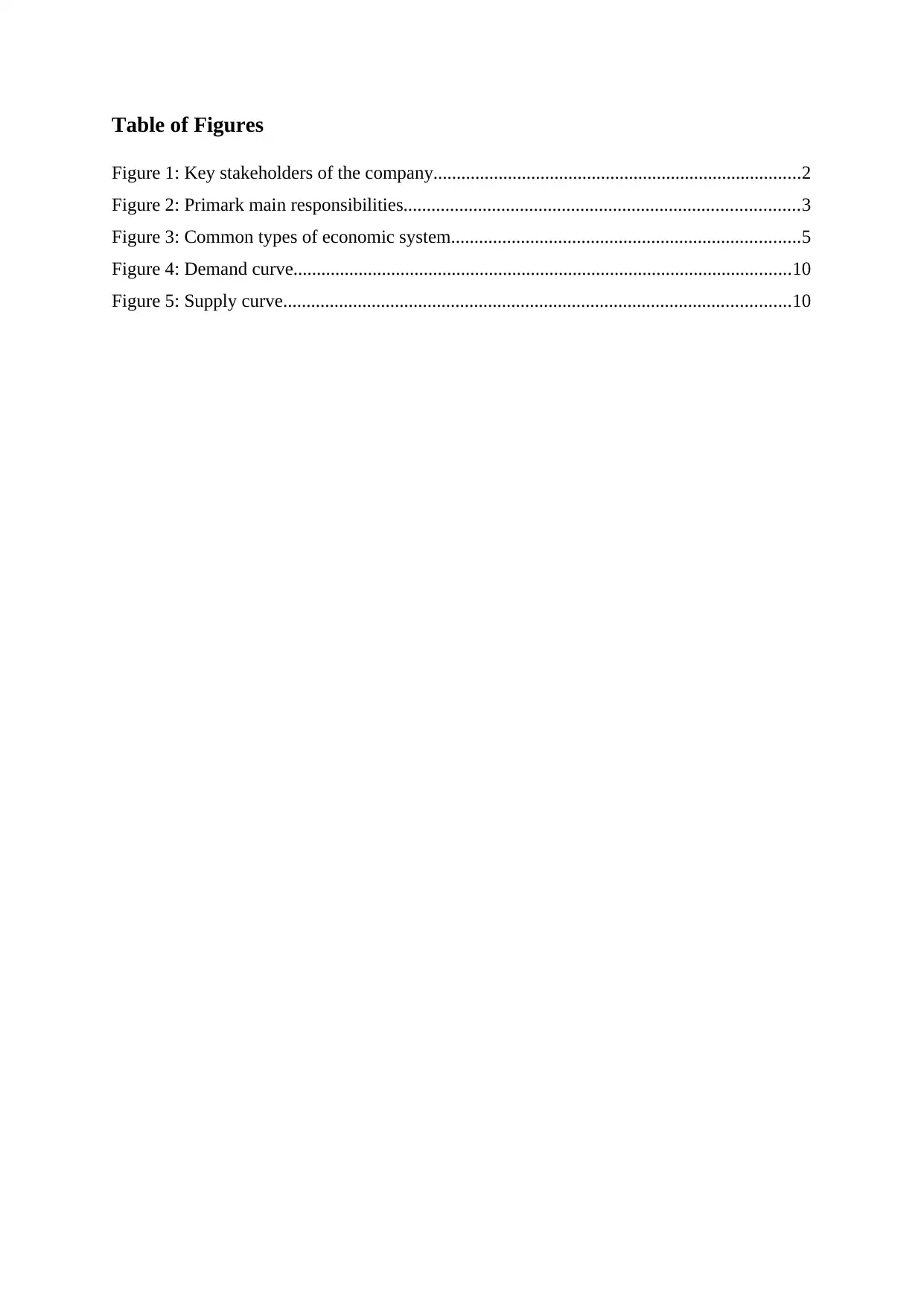
Table of Figures
Figure 1: Key stakeholders of the company...............................................................................2
Figure 2: Primark main responsibilities.....................................................................................3
Figure 3: Common types of economic system...........................................................................5
Figure 4: Demand curve...........................................................................................................10
Figure 5: Supply curve.............................................................................................................10
Figure 1: Key stakeholders of the company...............................................................................2
Figure 2: Primark main responsibilities.....................................................................................3
Figure 3: Common types of economic system...........................................................................5
Figure 4: Demand curve...........................................................................................................10
Figure 5: Supply curve.............................................................................................................10
⊘ This is a preview!⊘
Do you want full access?
Subscribe today to unlock all pages.

Trusted by 1+ million students worldwide
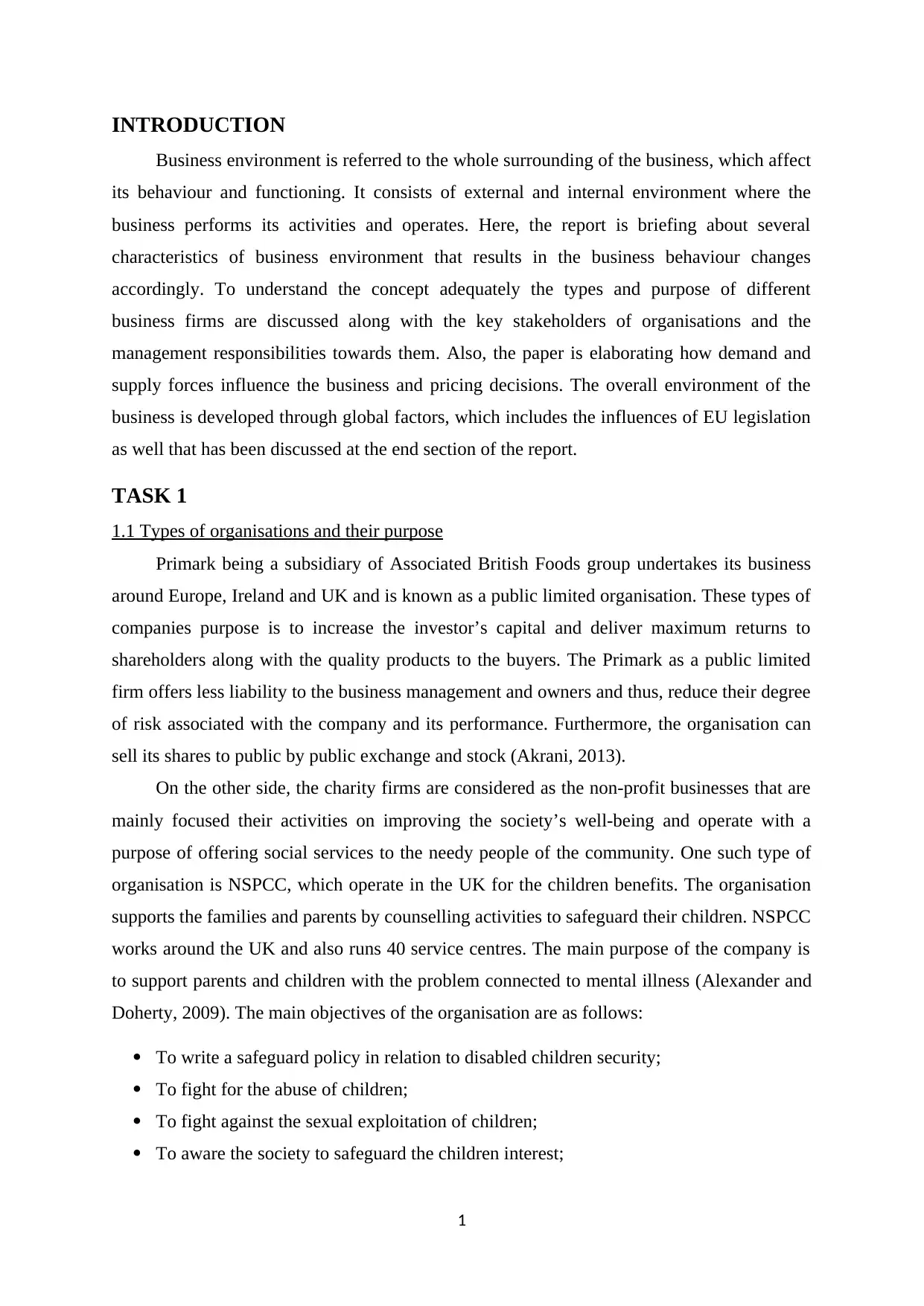
INTRODUCTION
Business environment is referred to the whole surrounding of the business, which affect
its behaviour and functioning. It consists of external and internal environment where the
business performs its activities and operates. Here, the report is briefing about several
characteristics of business environment that results in the business behaviour changes
accordingly. To understand the concept adequately the types and purpose of different
business firms are discussed along with the key stakeholders of organisations and the
management responsibilities towards them. Also, the paper is elaborating how demand and
supply forces influence the business and pricing decisions. The overall environment of the
business is developed through global factors, which includes the influences of EU legislation
as well that has been discussed at the end section of the report.
TASK 1
1.1 Types of organisations and their purpose
Primark being a subsidiary of Associated British Foods group undertakes its business
around Europe, Ireland and UK and is known as a public limited organisation. These types of
companies purpose is to increase the investor’s capital and deliver maximum returns to
shareholders along with the quality products to the buyers. The Primark as a public limited
firm offers less liability to the business management and owners and thus, reduce their degree
of risk associated with the company and its performance. Furthermore, the organisation can
sell its shares to public by public exchange and stock (Akrani, 2013).
On the other side, the charity firms are considered as the non-profit businesses that are
mainly focused their activities on improving the society’s well-being and operate with a
purpose of offering social services to the needy people of the community. One such type of
organisation is NSPCC, which operate in the UK for the children benefits. The organisation
supports the families and parents by counselling activities to safeguard their children. NSPCC
works around the UK and also runs 40 service centres. The main purpose of the company is
to support parents and children with the problem connected to mental illness (Alexander and
Doherty, 2009). The main objectives of the organisation are as follows:
To write a safeguard policy in relation to disabled children security;
To fight for the abuse of children;
To fight against the sexual exploitation of children;
To aware the society to safeguard the children interest;
1
Business environment is referred to the whole surrounding of the business, which affect
its behaviour and functioning. It consists of external and internal environment where the
business performs its activities and operates. Here, the report is briefing about several
characteristics of business environment that results in the business behaviour changes
accordingly. To understand the concept adequately the types and purpose of different
business firms are discussed along with the key stakeholders of organisations and the
management responsibilities towards them. Also, the paper is elaborating how demand and
supply forces influence the business and pricing decisions. The overall environment of the
business is developed through global factors, which includes the influences of EU legislation
as well that has been discussed at the end section of the report.
TASK 1
1.1 Types of organisations and their purpose
Primark being a subsidiary of Associated British Foods group undertakes its business
around Europe, Ireland and UK and is known as a public limited organisation. These types of
companies purpose is to increase the investor’s capital and deliver maximum returns to
shareholders along with the quality products to the buyers. The Primark as a public limited
firm offers less liability to the business management and owners and thus, reduce their degree
of risk associated with the company and its performance. Furthermore, the organisation can
sell its shares to public by public exchange and stock (Akrani, 2013).
On the other side, the charity firms are considered as the non-profit businesses that are
mainly focused their activities on improving the society’s well-being and operate with a
purpose of offering social services to the needy people of the community. One such type of
organisation is NSPCC, which operate in the UK for the children benefits. The organisation
supports the families and parents by counselling activities to safeguard their children. NSPCC
works around the UK and also runs 40 service centres. The main purpose of the company is
to support parents and children with the problem connected to mental illness (Alexander and
Doherty, 2009). The main objectives of the organisation are as follows:
To write a safeguard policy in relation to disabled children security;
To fight for the abuse of children;
To fight against the sexual exploitation of children;
To aware the society to safeguard the children interest;
1
Paraphrase This Document
Need a fresh take? Get an instant paraphrase of this document with our AI Paraphraser
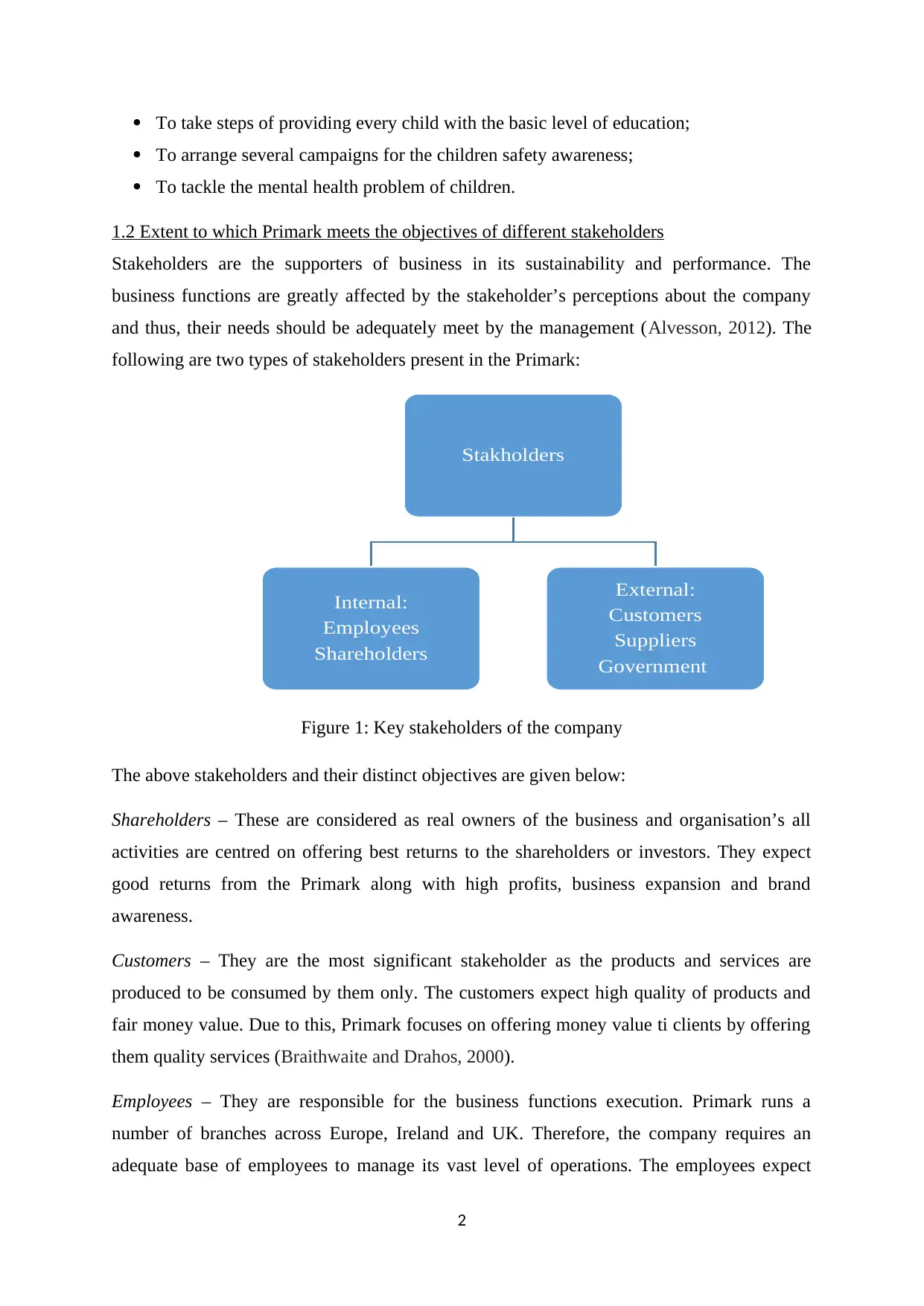
To take steps of providing every child with the basic level of education;
To arrange several campaigns for the children safety awareness;
To tackle the mental health problem of children.
1.2 Extent to which Primark meets the objectives of different stakeholders
Stakeholders are the supporters of business in its sustainability and performance. The
business functions are greatly affected by the stakeholder’s perceptions about the company
and thus, their needs should be adequately meet by the management (Alvesson, 2012). The
following are two types of stakeholders present in the Primark:
Figure 1: Key stakeholders of the company
The above stakeholders and their distinct objectives are given below:
Shareholders – These are considered as real owners of the business and organisation’s all
activities are centred on offering best returns to the shareholders or investors. They expect
good returns from the Primark along with high profits, business expansion and brand
awareness.
Customers – They are the most significant stakeholder as the products and services are
produced to be consumed by them only. The customers expect high quality of products and
fair money value. Due to this, Primark focuses on offering money value ti clients by offering
them quality services (Braithwaite and Drahos, 2000).
Employees – They are responsible for the business functions execution. Primark runs a
number of branches across Europe, Ireland and UK. Therefore, the company requires an
adequate base of employees to manage its vast level of operations. The employees expect
2
Stakholders
Internal:
Employees
Shareholders
External:
Customers
Suppliers
Government
To arrange several campaigns for the children safety awareness;
To tackle the mental health problem of children.
1.2 Extent to which Primark meets the objectives of different stakeholders
Stakeholders are the supporters of business in its sustainability and performance. The
business functions are greatly affected by the stakeholder’s perceptions about the company
and thus, their needs should be adequately meet by the management (Alvesson, 2012). The
following are two types of stakeholders present in the Primark:
Figure 1: Key stakeholders of the company
The above stakeholders and their distinct objectives are given below:
Shareholders – These are considered as real owners of the business and organisation’s all
activities are centred on offering best returns to the shareholders or investors. They expect
good returns from the Primark along with high profits, business expansion and brand
awareness.
Customers – They are the most significant stakeholder as the products and services are
produced to be consumed by them only. The customers expect high quality of products and
fair money value. Due to this, Primark focuses on offering money value ti clients by offering
them quality services (Braithwaite and Drahos, 2000).
Employees – They are responsible for the business functions execution. Primark runs a
number of branches across Europe, Ireland and UK. Therefore, the company requires an
adequate base of employees to manage its vast level of operations. The employees expect
2
Stakholders
Internal:
Employees
Shareholders
External:
Customers
Suppliers
Government
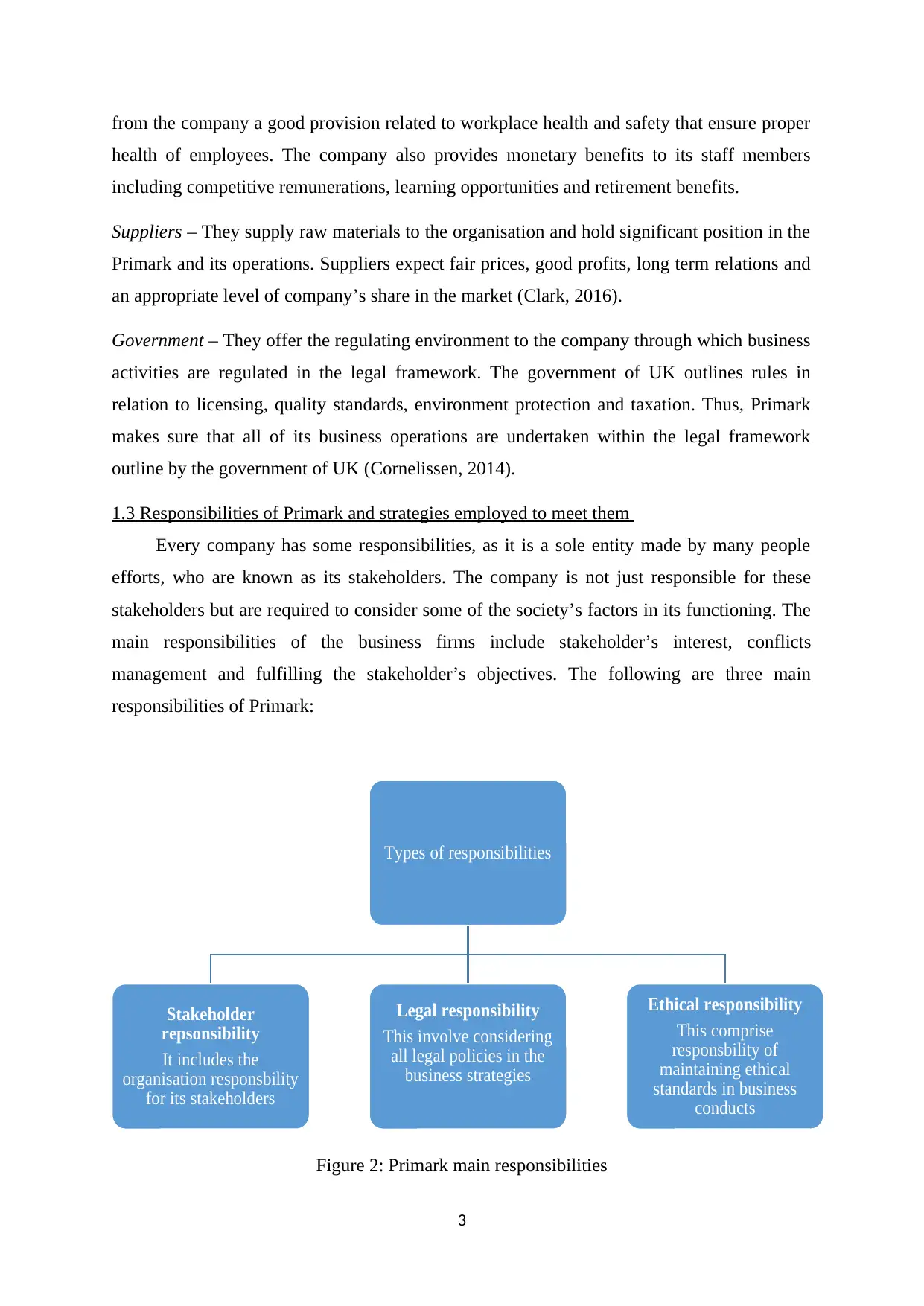
from the company a good provision related to workplace health and safety that ensure proper
health of employees. The company also provides monetary benefits to its staff members
including competitive remunerations, learning opportunities and retirement benefits.
Suppliers – They supply raw materials to the organisation and hold significant position in the
Primark and its operations. Suppliers expect fair prices, good profits, long term relations and
an appropriate level of company’s share in the market (Clark, 2016).
Government – They offer the regulating environment to the company through which business
activities are regulated in the legal framework. The government of UK outlines rules in
relation to licensing, quality standards, environment protection and taxation. Thus, Primark
makes sure that all of its business operations are undertaken within the legal framework
outline by the government of UK (Cornelissen, 2014).
1.3 Responsibilities of Primark and strategies employed to meet them
Every company has some responsibilities, as it is a sole entity made by many people
efforts, who are known as its stakeholders. The company is not just responsible for these
stakeholders but are required to consider some of the society’s factors in its functioning. The
main responsibilities of the business firms include stakeholder’s interest, conflicts
management and fulfilling the stakeholder’s objectives. The following are three main
responsibilities of Primark:
Figure 2: Primark main responsibilities
3
Types of responsibilities
Stakeholder
repsonsibility
It includes the
organisation responsbility
for its stakeholders
Legal responsibility
This involve considering
all legal policies in the
business strategies
Ethical responsibility
This comprise
responsbility of
maintaining ethical
standards in business
conducts
health of employees. The company also provides monetary benefits to its staff members
including competitive remunerations, learning opportunities and retirement benefits.
Suppliers – They supply raw materials to the organisation and hold significant position in the
Primark and its operations. Suppliers expect fair prices, good profits, long term relations and
an appropriate level of company’s share in the market (Clark, 2016).
Government – They offer the regulating environment to the company through which business
activities are regulated in the legal framework. The government of UK outlines rules in
relation to licensing, quality standards, environment protection and taxation. Thus, Primark
makes sure that all of its business operations are undertaken within the legal framework
outline by the government of UK (Cornelissen, 2014).
1.3 Responsibilities of Primark and strategies employed to meet them
Every company has some responsibilities, as it is a sole entity made by many people
efforts, who are known as its stakeholders. The company is not just responsible for these
stakeholders but are required to consider some of the society’s factors in its functioning. The
main responsibilities of the business firms include stakeholder’s interest, conflicts
management and fulfilling the stakeholder’s objectives. The following are three main
responsibilities of Primark:
Figure 2: Primark main responsibilities
3
Types of responsibilities
Stakeholder
repsonsibility
It includes the
organisation responsbility
for its stakeholders
Legal responsibility
This involve considering
all legal policies in the
business strategies
Ethical responsibility
This comprise
responsbility of
maintaining ethical
standards in business
conducts
⊘ This is a preview!⊘
Do you want full access?
Subscribe today to unlock all pages.

Trusted by 1+ million students worldwide
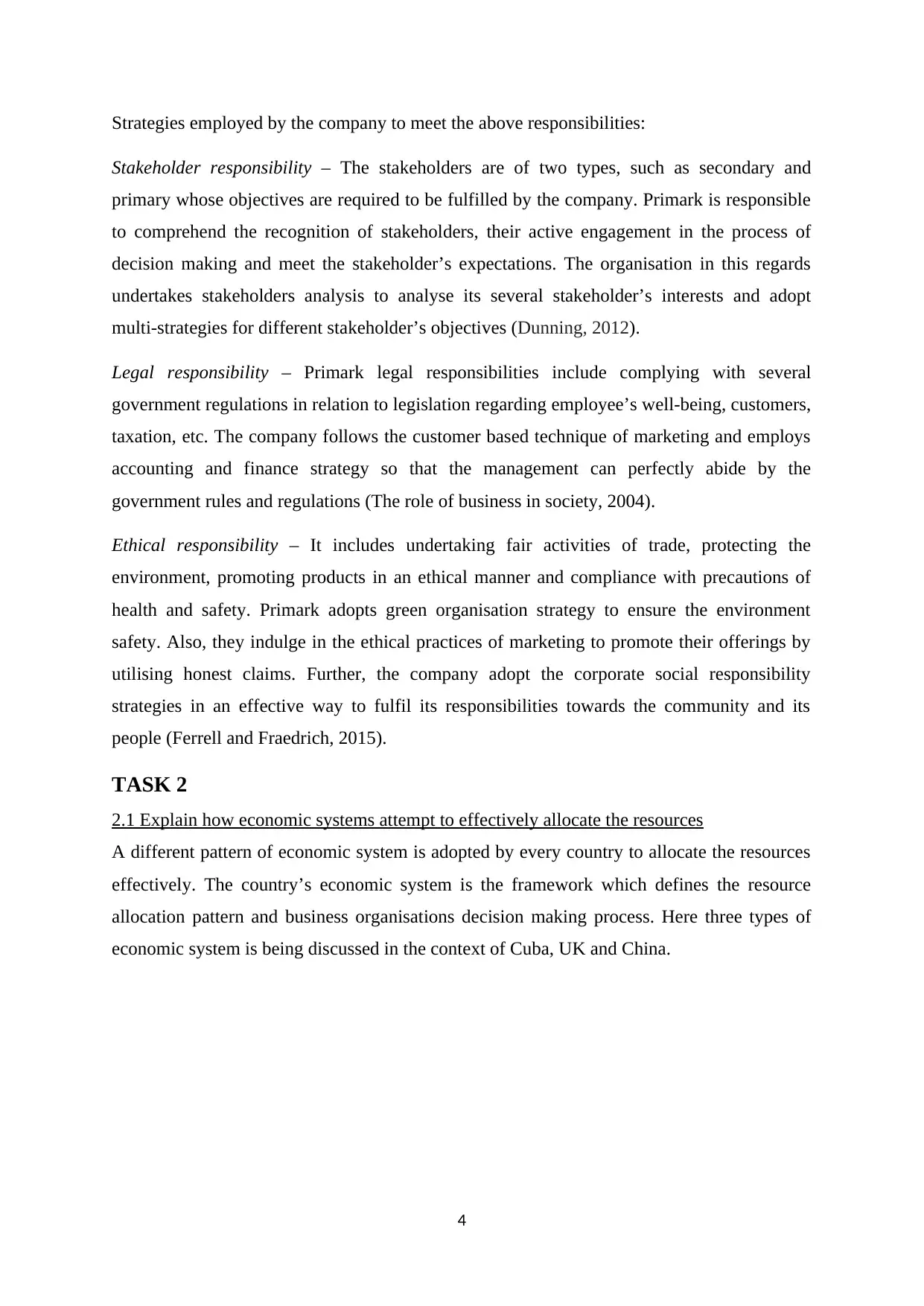
Strategies employed by the company to meet the above responsibilities:
Stakeholder responsibility – The stakeholders are of two types, such as secondary and
primary whose objectives are required to be fulfilled by the company. Primark is responsible
to comprehend the recognition of stakeholders, their active engagement in the process of
decision making and meet the stakeholder’s expectations. The organisation in this regards
undertakes stakeholders analysis to analyse its several stakeholder’s interests and adopt
multi-strategies for different stakeholder’s objectives (Dunning, 2012).
Legal responsibility – Primark legal responsibilities include complying with several
government regulations in relation to legislation regarding employee’s well-being, customers,
taxation, etc. The company follows the customer based technique of marketing and employs
accounting and finance strategy so that the management can perfectly abide by the
government rules and regulations (The role of business in society, 2004).
Ethical responsibility – It includes undertaking fair activities of trade, protecting the
environment, promoting products in an ethical manner and compliance with precautions of
health and safety. Primark adopts green organisation strategy to ensure the environment
safety. Also, they indulge in the ethical practices of marketing to promote their offerings by
utilising honest claims. Further, the company adopt the corporate social responsibility
strategies in an effective way to fulfil its responsibilities towards the community and its
people (Ferrell and Fraedrich, 2015).
TASK 2
2.1 Explain how economic systems attempt to effectively allocate the resources
A different pattern of economic system is adopted by every country to allocate the resources
effectively. The country’s economic system is the framework which defines the resource
allocation pattern and business organisations decision making process. Here three types of
economic system is being discussed in the context of Cuba, UK and China.
4
Stakeholder responsibility – The stakeholders are of two types, such as secondary and
primary whose objectives are required to be fulfilled by the company. Primark is responsible
to comprehend the recognition of stakeholders, their active engagement in the process of
decision making and meet the stakeholder’s expectations. The organisation in this regards
undertakes stakeholders analysis to analyse its several stakeholder’s interests and adopt
multi-strategies for different stakeholder’s objectives (Dunning, 2012).
Legal responsibility – Primark legal responsibilities include complying with several
government regulations in relation to legislation regarding employee’s well-being, customers,
taxation, etc. The company follows the customer based technique of marketing and employs
accounting and finance strategy so that the management can perfectly abide by the
government rules and regulations (The role of business in society, 2004).
Ethical responsibility – It includes undertaking fair activities of trade, protecting the
environment, promoting products in an ethical manner and compliance with precautions of
health and safety. Primark adopts green organisation strategy to ensure the environment
safety. Also, they indulge in the ethical practices of marketing to promote their offerings by
utilising honest claims. Further, the company adopt the corporate social responsibility
strategies in an effective way to fulfil its responsibilities towards the community and its
people (Ferrell and Fraedrich, 2015).
TASK 2
2.1 Explain how economic systems attempt to effectively allocate the resources
A different pattern of economic system is adopted by every country to allocate the resources
effectively. The country’s economic system is the framework which defines the resource
allocation pattern and business organisations decision making process. Here three types of
economic system is being discussed in the context of Cuba, UK and China.
4
Paraphrase This Document
Need a fresh take? Get an instant paraphrase of this document with our AI Paraphraser
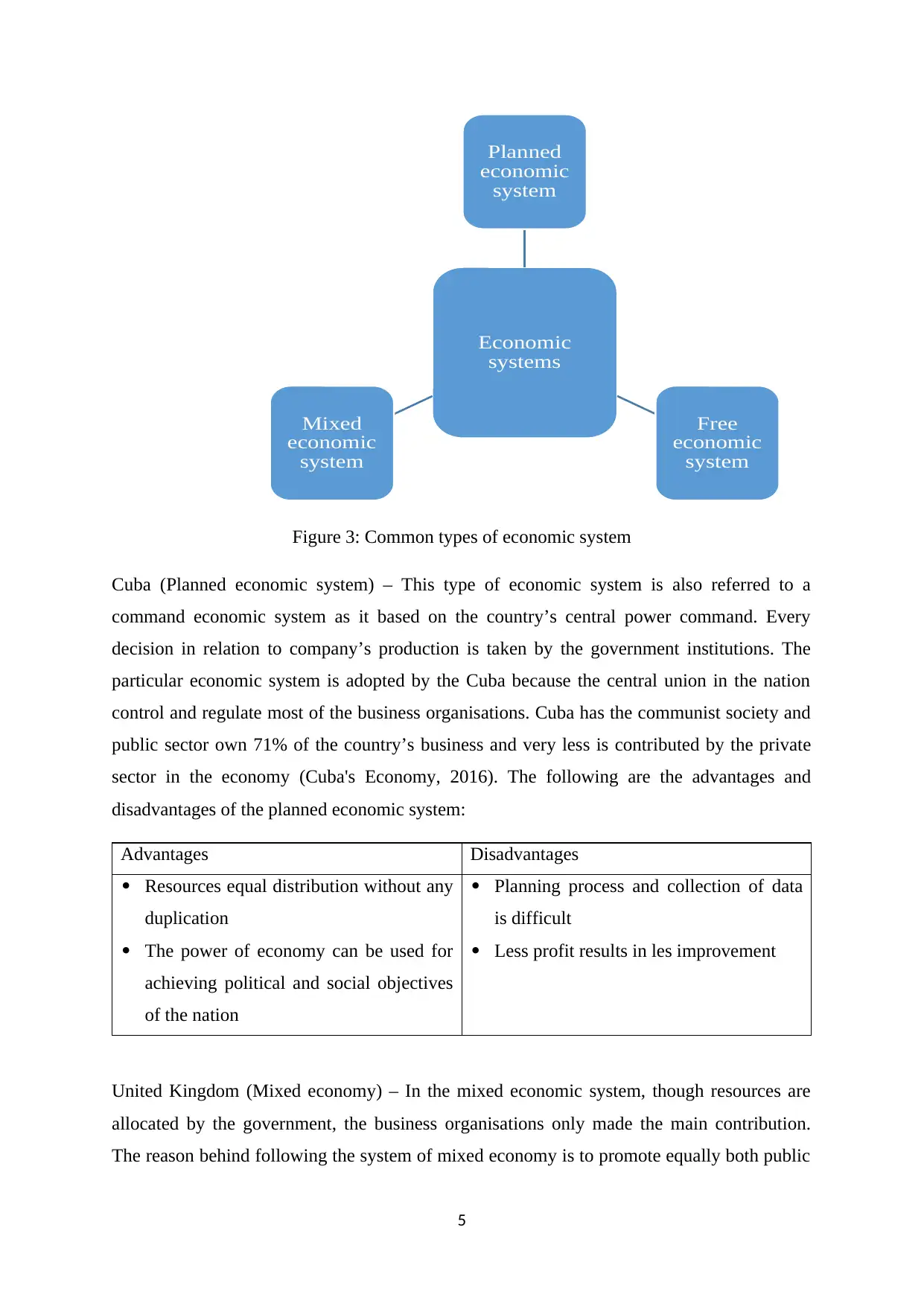
Figure 3: Common types of economic system
Cuba (Planned economic system) – This type of economic system is also referred to a
command economic system as it based on the country’s central power command. Every
decision in relation to company’s production is taken by the government institutions. The
particular economic system is adopted by the Cuba because the central union in the nation
control and regulate most of the business organisations. Cuba has the communist society and
public sector own 71% of the country’s business and very less is contributed by the private
sector in the economy (Cuba's Economy, 2016). The following are the advantages and
disadvantages of the planned economic system:
Advantages Disadvantages
Resources equal distribution without any
duplication
The power of economy can be used for
achieving political and social objectives
of the nation
Planning process and collection of data
is difficult
Less profit results in les improvement
United Kingdom (Mixed economy) – In the mixed economic system, though resources are
allocated by the government, the business organisations only made the main contribution.
The reason behind following the system of mixed economy is to promote equally both public
5
Economic
systems
Planned
economic
system
Free
economic
system
Mixed
economic
system
Cuba (Planned economic system) – This type of economic system is also referred to a
command economic system as it based on the country’s central power command. Every
decision in relation to company’s production is taken by the government institutions. The
particular economic system is adopted by the Cuba because the central union in the nation
control and regulate most of the business organisations. Cuba has the communist society and
public sector own 71% of the country’s business and very less is contributed by the private
sector in the economy (Cuba's Economy, 2016). The following are the advantages and
disadvantages of the planned economic system:
Advantages Disadvantages
Resources equal distribution without any
duplication
The power of economy can be used for
achieving political and social objectives
of the nation
Planning process and collection of data
is difficult
Less profit results in les improvement
United Kingdom (Mixed economy) – In the mixed economic system, though resources are
allocated by the government, the business organisations only made the main contribution.
The reason behind following the system of mixed economy is to promote equally both public
5
Economic
systems
Planned
economic
system
Free
economic
system
Mixed
economic
system
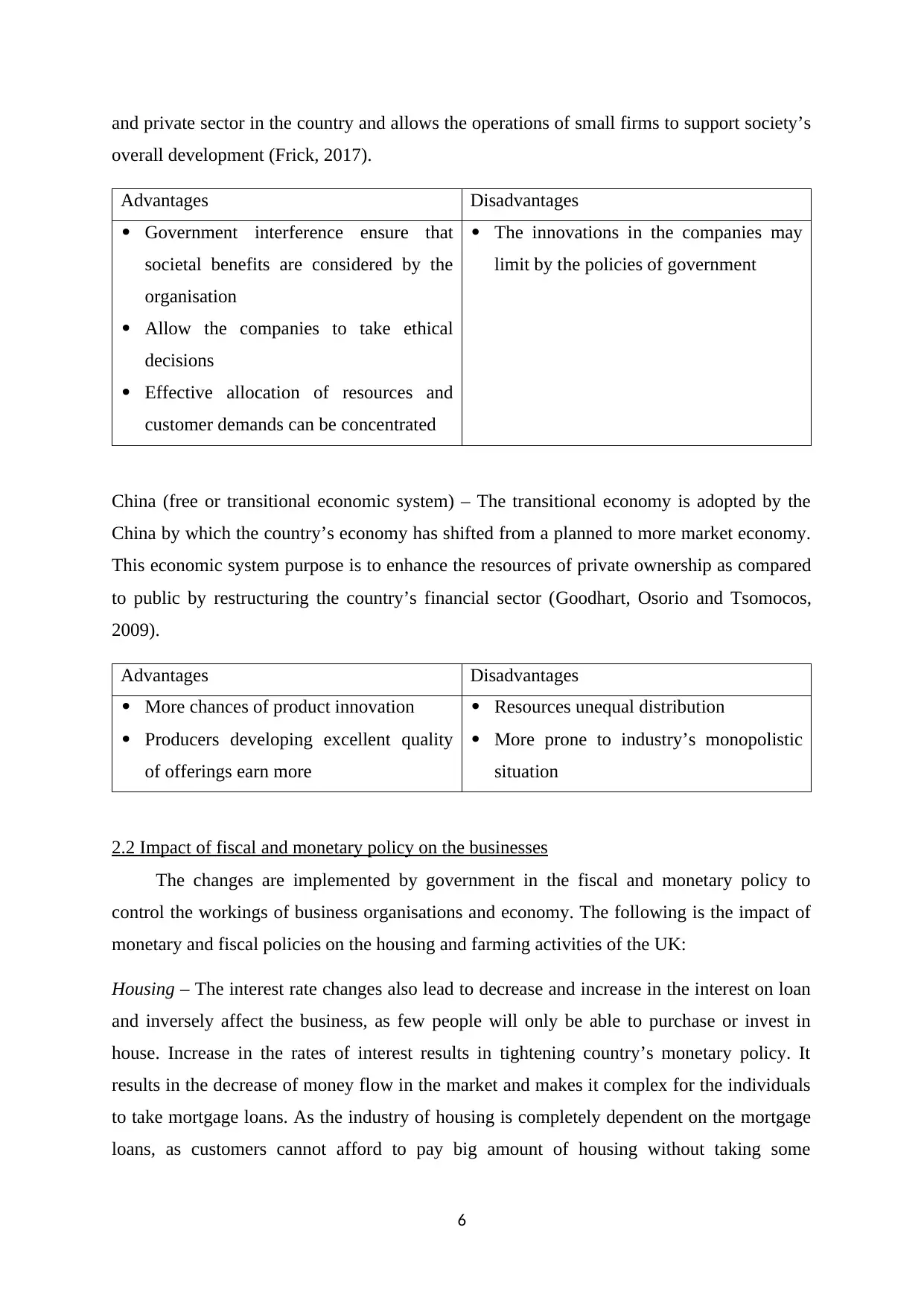
and private sector in the country and allows the operations of small firms to support society’s
overall development (Frick, 2017).
Advantages Disadvantages
Government interference ensure that
societal benefits are considered by the
organisation
Allow the companies to take ethical
decisions
Effective allocation of resources and
customer demands can be concentrated
The innovations in the companies may
limit by the policies of government
China (free or transitional economic system) – The transitional economy is adopted by the
China by which the country’s economy has shifted from a planned to more market economy.
This economic system purpose is to enhance the resources of private ownership as compared
to public by restructuring the country’s financial sector (Goodhart, Osorio and Tsomocos,
2009).
Advantages Disadvantages
More chances of product innovation
Producers developing excellent quality
of offerings earn more
Resources unequal distribution
More prone to industry’s monopolistic
situation
2.2 Impact of fiscal and monetary policy on the businesses
The changes are implemented by government in the fiscal and monetary policy to
control the workings of business organisations and economy. The following is the impact of
monetary and fiscal policies on the housing and farming activities of the UK:
Housing – The interest rate changes also lead to decrease and increase in the interest on loan
and inversely affect the business, as few people will only be able to purchase or invest in
house. Increase in the rates of interest results in tightening country’s monetary policy. It
results in the decrease of money flow in the market and makes it complex for the individuals
to take mortgage loans. As the industry of housing is completely dependent on the mortgage
loans, as customers cannot afford to pay big amount of housing without taking some
6
overall development (Frick, 2017).
Advantages Disadvantages
Government interference ensure that
societal benefits are considered by the
organisation
Allow the companies to take ethical
decisions
Effective allocation of resources and
customer demands can be concentrated
The innovations in the companies may
limit by the policies of government
China (free or transitional economic system) – The transitional economy is adopted by the
China by which the country’s economy has shifted from a planned to more market economy.
This economic system purpose is to enhance the resources of private ownership as compared
to public by restructuring the country’s financial sector (Goodhart, Osorio and Tsomocos,
2009).
Advantages Disadvantages
More chances of product innovation
Producers developing excellent quality
of offerings earn more
Resources unequal distribution
More prone to industry’s monopolistic
situation
2.2 Impact of fiscal and monetary policy on the businesses
The changes are implemented by government in the fiscal and monetary policy to
control the workings of business organisations and economy. The following is the impact of
monetary and fiscal policies on the housing and farming activities of the UK:
Housing – The interest rate changes also lead to decrease and increase in the interest on loan
and inversely affect the business, as few people will only be able to purchase or invest in
house. Increase in the rates of interest results in tightening country’s monetary policy. It
results in the decrease of money flow in the market and makes it complex for the individuals
to take mortgage loans. As the industry of housing is completely dependent on the mortgage
loans, as customers cannot afford to pay big amount of housing without taking some
6
⊘ This is a preview!⊘
Do you want full access?
Subscribe today to unlock all pages.

Trusted by 1+ million students worldwide
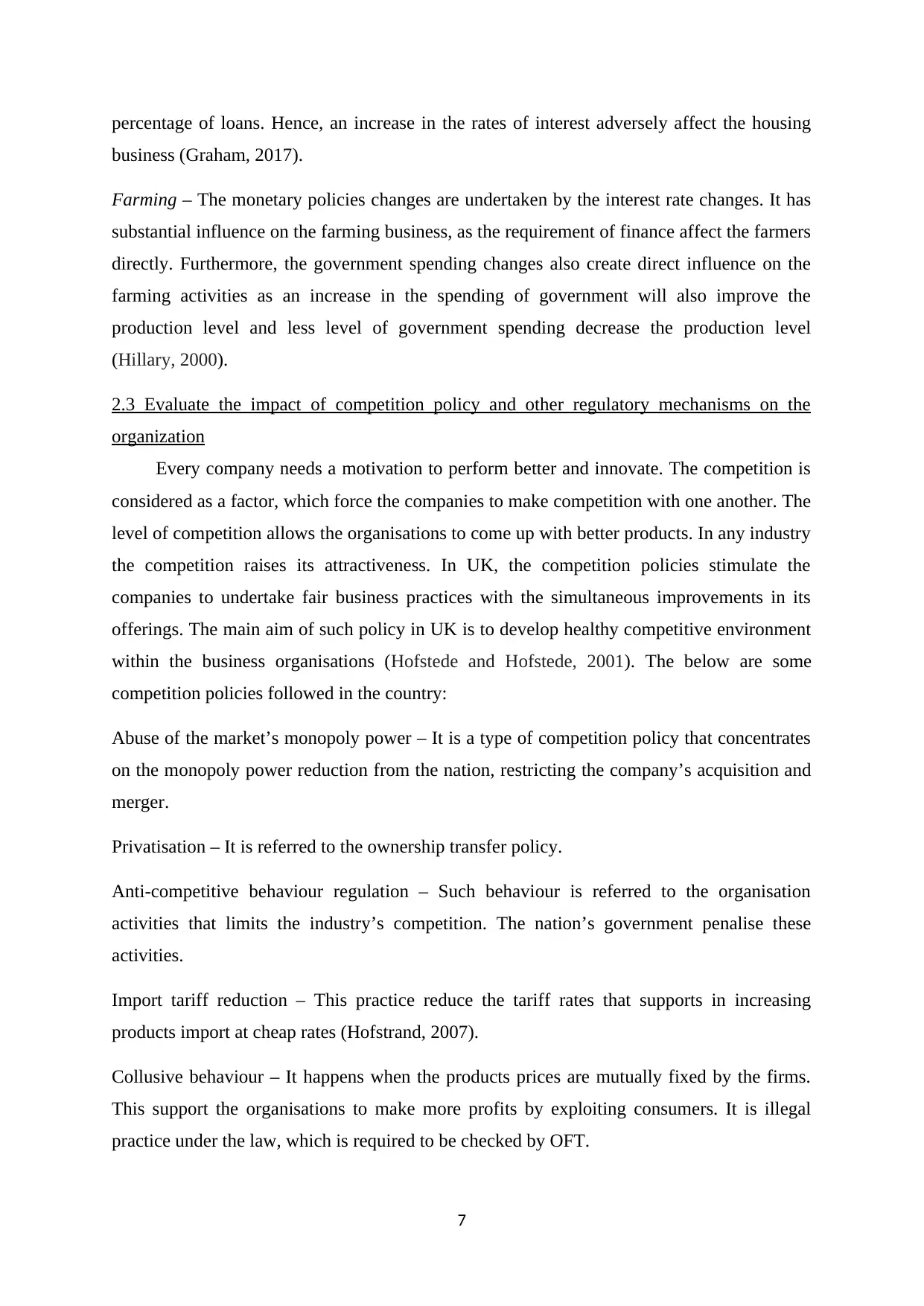
percentage of loans. Hence, an increase in the rates of interest adversely affect the housing
business (Graham, 2017).
Farming – The monetary policies changes are undertaken by the interest rate changes. It has
substantial influence on the farming business, as the requirement of finance affect the farmers
directly. Furthermore, the government spending changes also create direct influence on the
farming activities as an increase in the spending of government will also improve the
production level and less level of government spending decrease the production level
(Hillary, 2000).
2.3 Evaluate the impact of competition policy and other regulatory mechanisms on the
organization
Every company needs a motivation to perform better and innovate. The competition is
considered as a factor, which force the companies to make competition with one another. The
level of competition allows the organisations to come up with better products. In any industry
the competition raises its attractiveness. In UK, the competition policies stimulate the
companies to undertake fair business practices with the simultaneous improvements in its
offerings. The main aim of such policy in UK is to develop healthy competitive environment
within the business organisations (Hofstede and Hofstede, 2001). The below are some
competition policies followed in the country:
Abuse of the market’s monopoly power – It is a type of competition policy that concentrates
on the monopoly power reduction from the nation, restricting the company’s acquisition and
merger.
Privatisation – It is referred to the ownership transfer policy.
Anti-competitive behaviour regulation – Such behaviour is referred to the organisation
activities that limits the industry’s competition. The nation’s government penalise these
activities.
Import tariff reduction – This practice reduce the tariff rates that supports in increasing
products import at cheap rates (Hofstrand, 2007).
Collusive behaviour – It happens when the products prices are mutually fixed by the firms.
This support the organisations to make more profits by exploiting consumers. It is illegal
practice under the law, which is required to be checked by OFT.
7
business (Graham, 2017).
Farming – The monetary policies changes are undertaken by the interest rate changes. It has
substantial influence on the farming business, as the requirement of finance affect the farmers
directly. Furthermore, the government spending changes also create direct influence on the
farming activities as an increase in the spending of government will also improve the
production level and less level of government spending decrease the production level
(Hillary, 2000).
2.3 Evaluate the impact of competition policy and other regulatory mechanisms on the
organization
Every company needs a motivation to perform better and innovate. The competition is
considered as a factor, which force the companies to make competition with one another. The
level of competition allows the organisations to come up with better products. In any industry
the competition raises its attractiveness. In UK, the competition policies stimulate the
companies to undertake fair business practices with the simultaneous improvements in its
offerings. The main aim of such policy in UK is to develop healthy competitive environment
within the business organisations (Hofstede and Hofstede, 2001). The below are some
competition policies followed in the country:
Abuse of the market’s monopoly power – It is a type of competition policy that concentrates
on the monopoly power reduction from the nation, restricting the company’s acquisition and
merger.
Privatisation – It is referred to the ownership transfer policy.
Anti-competitive behaviour regulation – Such behaviour is referred to the organisation
activities that limits the industry’s competition. The nation’s government penalise these
activities.
Import tariff reduction – This practice reduce the tariff rates that supports in increasing
products import at cheap rates (Hofstrand, 2007).
Collusive behaviour – It happens when the products prices are mutually fixed by the firms.
This support the organisations to make more profits by exploiting consumers. It is illegal
practice under the law, which is required to be checked by OFT.
7
Paraphrase This Document
Need a fresh take? Get an instant paraphrase of this document with our AI Paraphraser
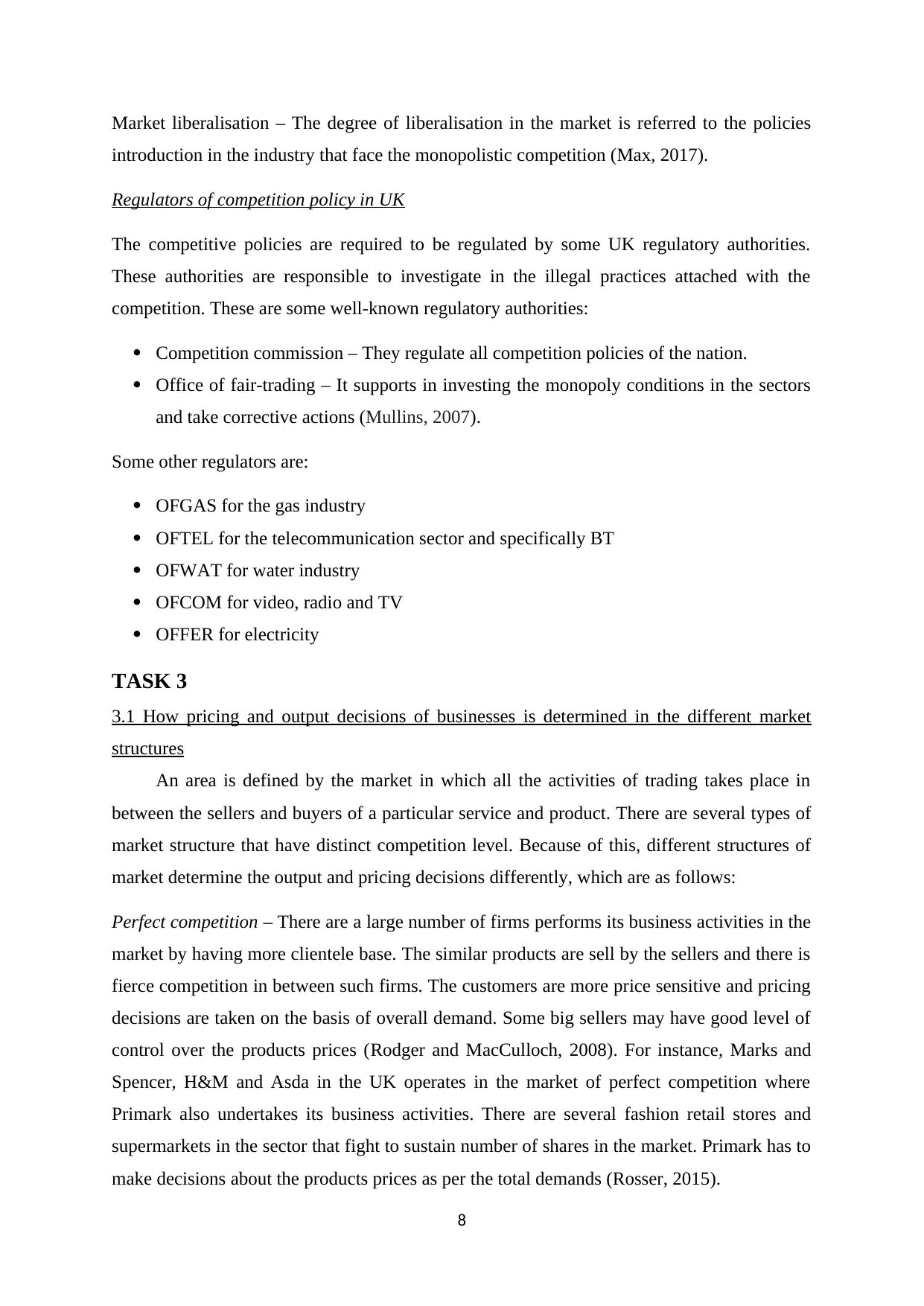
Market liberalisation – The degree of liberalisation in the market is referred to the policies
introduction in the industry that face the monopolistic competition (Max, 2017).
Regulators of competition policy in UK
The competitive policies are required to be regulated by some UK regulatory authorities.
These authorities are responsible to investigate in the illegal practices attached with the
competition. These are some well-known regulatory authorities:
Competition commission – They regulate all competition policies of the nation.
Office of fair-trading – It supports in investing the monopoly conditions in the sectors
and take corrective actions (Mullins, 2007).
Some other regulators are:
OFGAS for the gas industry
OFTEL for the telecommunication sector and specifically BT
OFWAT for water industry
OFCOM for video, radio and TV
OFFER for electricity
TASK 3
3.1 How pricing and output decisions of businesses is determined in the different market
structures
An area is defined by the market in which all the activities of trading takes place in
between the sellers and buyers of a particular service and product. There are several types of
market structure that have distinct competition level. Because of this, different structures of
market determine the output and pricing decisions differently, which are as follows:
Perfect competition – There are a large number of firms performs its business activities in the
market by having more clientele base. The similar products are sell by the sellers and there is
fierce competition in between such firms. The customers are more price sensitive and pricing
decisions are taken on the basis of overall demand. Some big sellers may have good level of
control over the products prices (Rodger and MacCulloch, 2008). For instance, Marks and
Spencer, H&M and Asda in the UK operates in the market of perfect competition where
Primark also undertakes its business activities. There are several fashion retail stores and
supermarkets in the sector that fight to sustain number of shares in the market. Primark has to
make decisions about the products prices as per the total demands (Rosser, 2015).
8
introduction in the industry that face the monopolistic competition (Max, 2017).
Regulators of competition policy in UK
The competitive policies are required to be regulated by some UK regulatory authorities.
These authorities are responsible to investigate in the illegal practices attached with the
competition. These are some well-known regulatory authorities:
Competition commission – They regulate all competition policies of the nation.
Office of fair-trading – It supports in investing the monopoly conditions in the sectors
and take corrective actions (Mullins, 2007).
Some other regulators are:
OFGAS for the gas industry
OFTEL for the telecommunication sector and specifically BT
OFWAT for water industry
OFCOM for video, radio and TV
OFFER for electricity
TASK 3
3.1 How pricing and output decisions of businesses is determined in the different market
structures
An area is defined by the market in which all the activities of trading takes place in
between the sellers and buyers of a particular service and product. There are several types of
market structure that have distinct competition level. Because of this, different structures of
market determine the output and pricing decisions differently, which are as follows:
Perfect competition – There are a large number of firms performs its business activities in the
market by having more clientele base. The similar products are sell by the sellers and there is
fierce competition in between such firms. The customers are more price sensitive and pricing
decisions are taken on the basis of overall demand. Some big sellers may have good level of
control over the products prices (Rodger and MacCulloch, 2008). For instance, Marks and
Spencer, H&M and Asda in the UK operates in the market of perfect competition where
Primark also undertakes its business activities. There are several fashion retail stores and
supermarkets in the sector that fight to sustain number of shares in the market. Primark has to
make decisions about the products prices as per the total demands (Rosser, 2015).
8
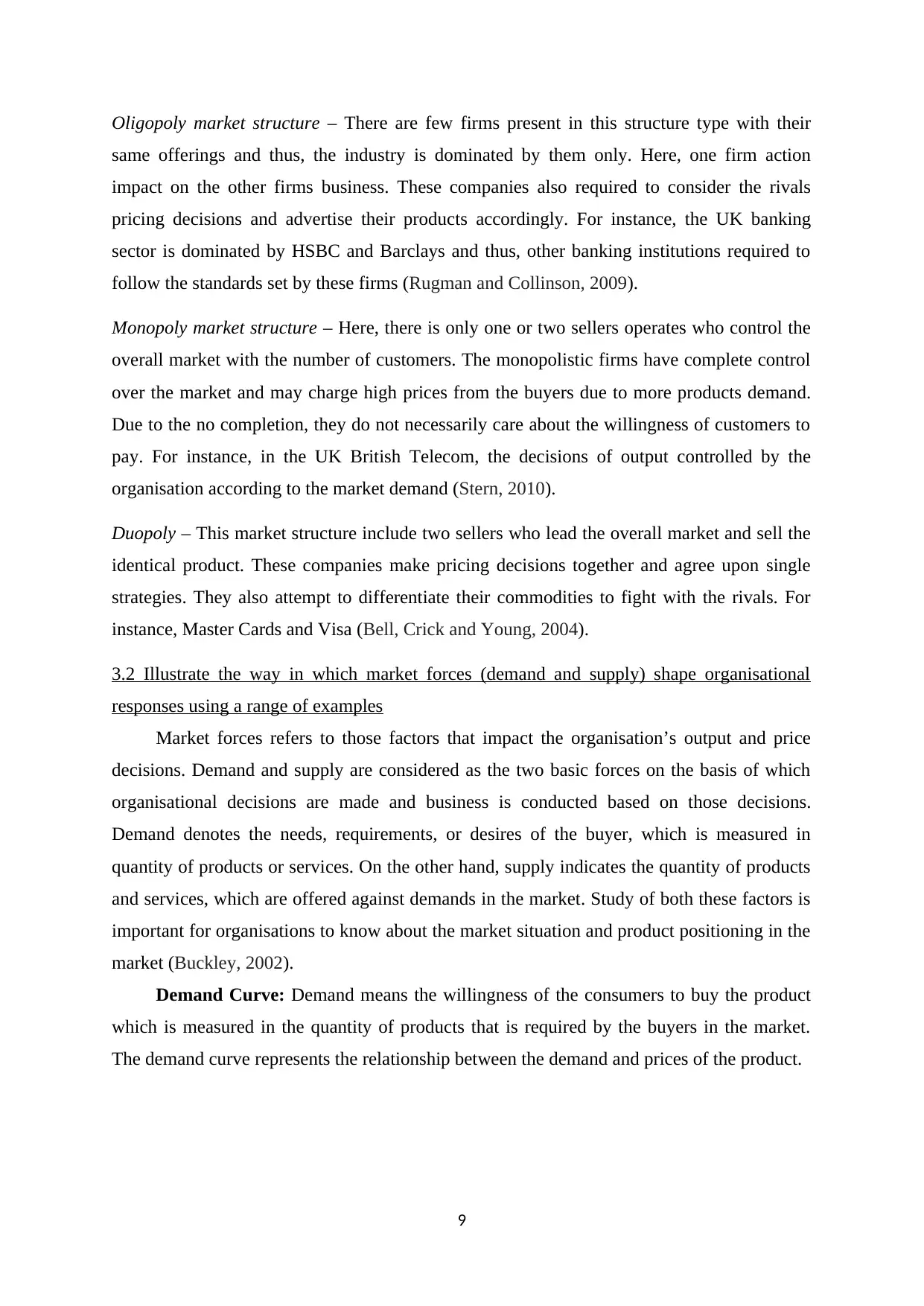
Oligopoly market structure – There are few firms present in this structure type with their
same offerings and thus, the industry is dominated by them only. Here, one firm action
impact on the other firms business. These companies also required to consider the rivals
pricing decisions and advertise their products accordingly. For instance, the UK banking
sector is dominated by HSBC and Barclays and thus, other banking institutions required to
follow the standards set by these firms (Rugman and Collinson, 2009).
Monopoly market structure – Here, there is only one or two sellers operates who control the
overall market with the number of customers. The monopolistic firms have complete control
over the market and may charge high prices from the buyers due to more products demand.
Due to the no completion, they do not necessarily care about the willingness of customers to
pay. For instance, in the UK British Telecom, the decisions of output controlled by the
organisation according to the market demand (Stern, 2010).
Duopoly – This market structure include two sellers who lead the overall market and sell the
identical product. These companies make pricing decisions together and agree upon single
strategies. They also attempt to differentiate their commodities to fight with the rivals. For
instance, Master Cards and Visa (Bell, Crick and Young, 2004).
3.2 Illustrate the way in which market forces (demand and supply) shape organisational
responses using a range of examples
Market forces refers to those factors that impact the organisation’s output and price
decisions. Demand and supply are considered as the two basic forces on the basis of which
organisational decisions are made and business is conducted based on those decisions.
Demand denotes the needs, requirements, or desires of the buyer, which is measured in
quantity of products or services. On the other hand, supply indicates the quantity of products
and services, which are offered against demands in the market. Study of both these factors is
important for organisations to know about the market situation and product positioning in the
market (Buckley, 2002).
Demand Curve: Demand means the willingness of the consumers to buy the product
which is measured in the quantity of products that is required by the buyers in the market.
The demand curve represents the relationship between the demand and prices of the product.
9
same offerings and thus, the industry is dominated by them only. Here, one firm action
impact on the other firms business. These companies also required to consider the rivals
pricing decisions and advertise their products accordingly. For instance, the UK banking
sector is dominated by HSBC and Barclays and thus, other banking institutions required to
follow the standards set by these firms (Rugman and Collinson, 2009).
Monopoly market structure – Here, there is only one or two sellers operates who control the
overall market with the number of customers. The monopolistic firms have complete control
over the market and may charge high prices from the buyers due to more products demand.
Due to the no completion, they do not necessarily care about the willingness of customers to
pay. For instance, in the UK British Telecom, the decisions of output controlled by the
organisation according to the market demand (Stern, 2010).
Duopoly – This market structure include two sellers who lead the overall market and sell the
identical product. These companies make pricing decisions together and agree upon single
strategies. They also attempt to differentiate their commodities to fight with the rivals. For
instance, Master Cards and Visa (Bell, Crick and Young, 2004).
3.2 Illustrate the way in which market forces (demand and supply) shape organisational
responses using a range of examples
Market forces refers to those factors that impact the organisation’s output and price
decisions. Demand and supply are considered as the two basic forces on the basis of which
organisational decisions are made and business is conducted based on those decisions.
Demand denotes the needs, requirements, or desires of the buyer, which is measured in
quantity of products or services. On the other hand, supply indicates the quantity of products
and services, which are offered against demands in the market. Study of both these factors is
important for organisations to know about the market situation and product positioning in the
market (Buckley, 2002).
Demand Curve: Demand means the willingness of the consumers to buy the product
which is measured in the quantity of products that is required by the buyers in the market.
The demand curve represents the relationship between the demand and prices of the product.
9
⊘ This is a preview!⊘
Do you want full access?
Subscribe today to unlock all pages.

Trusted by 1+ million students worldwide
1 out of 20
Related Documents
Your All-in-One AI-Powered Toolkit for Academic Success.
+13062052269
info@desklib.com
Available 24*7 on WhatsApp / Email
![[object Object]](/_next/static/media/star-bottom.7253800d.svg)
Unlock your academic potential
Copyright © 2020–2025 A2Z Services. All Rights Reserved. Developed and managed by ZUCOL.





